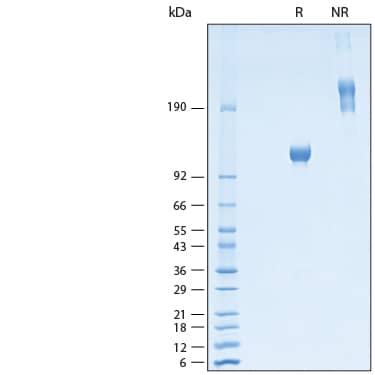Recombinant Rat Osteoactivin/GPNMB Fc Chimera Protein, CF
R&D Systems, part of Bio-Techne | Catalog # 11203-AC

Key Product Details
- R&D Systems HEK293-derived Recombinant Rat Osteoactivin/GPNMB Fc Chimera Protein (11203-AC)
- Quality control testing to verify active proteins with lot specific assays by in-house scientists
- All R&D Systems proteins are covered with a 100% guarantee
Source
Accession #
Structure / Form
Conjugate
Applications
Product Specifications
Source
| Rat Osteoactivin (Lys23-Asn500) Accession # NP_579832.1 |
IEGRMDP | Mouse IgG2a (Glu98-Lys330) |
| N-terminus | C-terminus |
Purity
Endotoxin Level
N-terminal Sequence Analysis
Predicted Molecular Mass
SDS-PAGE
Activity
When Recombinant Mouse Integrin alphaV beta3 (Catalog # 7889-AV) is immobilized at 2 µg/mL (100 µL/well), Recombinant Rat Osteoactivin/GPNMB Fc Chimera (Catalog # 11203-AC) binds with an ED50 of 0.700-7.00 µg/mL.
Scientific Data Images for Recombinant Rat Osteoactivin/GPNMB Fc Chimera Protein, CF
Recombinant Rat Osteoactivin/GPNMB Fc Chimera Protein SDS-PAGE.
2 μg/lane of Recombinant Rat Osteoactivin/GPNMB Fc Chimera Protein (Catalog # 11203-AC) was resolved with SDS-PAGE under reducing (R) and non-reducing (NR) conditions and visualized by Coomassie® Blue staining, showing bands at 100-122 kDa and 200-240 kDa, respectively.Formulation, Preparation and Storage
11203-AC
| Formulation | Lyophilized from a 0.2 μm filtered solution in PBS with Trehalose. |
| Reconstitution | Reconstitute at 500 μg/mL in PBS. |
| Shipping | The product is shipped at ambient temperature. Upon receipt, store it immediately at the temperature recommended below. |
| Stability & Storage | Use a manual defrost freezer and avoid repeated freeze-thaw cycles.
|
Background: Osteoactivin/GPNMB
Osteoactivin (also GPNMB and DC-HIL) is a variably glycosylated 75 - 125 kDa member of the NMB/pMEL-17 family of molecules. It is found in multiple subcellular sites, but is most often associated with the endosomal/lysosomal compartment (1, 2, 3). Human Osteoactivin is a 560 amino acid (aa) type I transmembrane protein. Its precursor contains a 21 aa signal sequence, a 465 aa luminal/extracellular domain, a 21 aa transmembrane segment and a 53 aa cytoplasmic tail (4, 5). The luminal region contains an N-terminal heparin-binding motif (aa 23 - 26), multiple glycosylation sites, an RGD motif (aa 64 - 66) and an 88 aa PKD domain (aa 240 - 327). The intracellular tail has an ITAM (Y-x-x-I) and lysosomal targeting (L-L) motif (4, 5). The extracellular/luminal region of rat Osteoactivin shares 71% and 89% aa identity with human and mouse Osteoactivin. Multiple isoforms would appear to exist. There is one alternate splice form known that shows a 12 aa insert between aa 339 - 340 (6). An addtional 206 aa isoform shows a mutation at position # 181 that results in a 26 aa substitution for the C-terminal 380 amino acids (7, 8). This has the potential to be soluble and may represent a counterpart to a secreted isoform of rat Osteoactivin (9). Cells known to express Osteoactivin include macrophages/Kupffer cells, fibroblasts, osteoblasts, myeloid dendritic cells, retinal pigment epithelial cells and melanocytes, plus fetal chondrocytes and stratum basale keratinocytes (3, 4, 5, 10, 11, 12). In mice, Osteoactivin is reported to bind to heparan sulfate-proteoglycan, possibly on the surface of endothelial cells and may also interact with integrins (13). It also appears to act as an inflammatory suppressor gene, as its expression downregulates the macrophage inflammatory response by inhibiting IL-6 and IL-12p40 production (3).
References
- Bachner, D. et al. (2002) Gene Exp. Patterns 1:159.
- Safadi, F.F. et al. (2002) J. Cell. Biochem. 84:12.
- Ripoll, V.M. et al. (2007) J. Immunol. 178:6557.
- Owen, T.A. et al. (2003) Crit. Rev. Eukaryot. Gene Expr. 13:205.
- Weterman, M.A.J. et al. (1995) Int. J. Cancer 60:73.
- Kuan, C-T. et al. (2006) Clin. Cancer Res. 12:1970.
- Lennerz, V. et al. (2005) Proc. Natl. Acad. Sci. USA 102:16013.
- Genbank Accession # AAH11595.
- Abdelmagid, S.M. et al. (2007) J. Cell. Physiol. 210:26.
- Haralanova-Ilieva, B. et al. (2005) J. Hepatol. 42:565.
- Ahn, J.H. et al. (2002) Blood 100:1742.
- Anderson, M.G. et al. (2002) Nat. Genet. 30:81.
- Shikano, S. et al. (2001) J. Biol. Chem. 276:8125.
Long Name
Alternate Names
Gene Symbol
UniProt
Additional Osteoactivin/GPNMB Products
Product Documents for Recombinant Rat Osteoactivin/GPNMB Fc Chimera Protein, CF
Product Specific Notices for Recombinant Rat Osteoactivin/GPNMB Fc Chimera Protein, CF
For research use only
